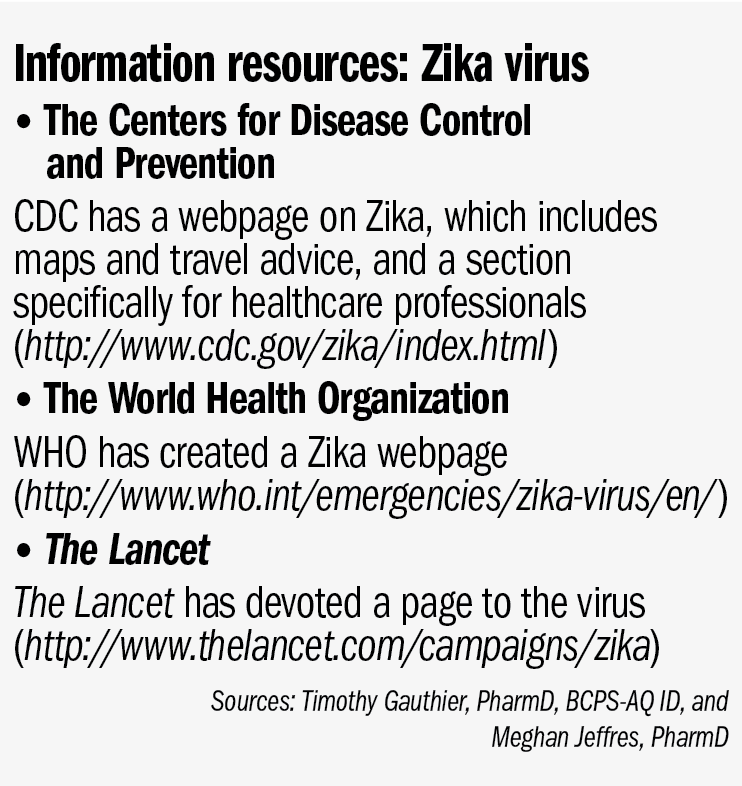What pharmacists should know about the Zika virus
Cases have been identified in the U.S. Now summer is coming, and this virus is most commonly transmitted by mosquitoes, so it is expected to spread more widely.
Cases of Zika virus - an arbovirus that has been determined by CDC to cause microcephaly and other severe fetal brain defects - have already been documented in the United States, mostly in travelers who have returned from areas where the virus is endemic or

Meghan Jeffresin the sexual partners of those travelers. But summer is coming, and this virus is most commonly transmitted by mosquitoes, so it is expected to spread more widely.
Pharmacists can educate patients about Zika. “Pharmacists are well positioned to provide information and to direct patients to reliable resources,” said Meghan Jeffres, PharmD, assistant professor, Department of Clinical Pharmacy, University of Colorado Skaggs School of Pharmacy.
See also: Another state shields identities of providers of lethal-injection drugs
Transmission
The virus has been detected in most of South and Central America, as well as in the Caribbean. It is

Timothy Gauthier transmitted mainly by Aedes species mosquitoes, but also can be spread by men during unprotected sex, said Timothy Gauthier, PharmD, BCPS-AQ ID. Gauthier is an antimicrobial stewardship pharmacist in the Miami Veterans Affairs Healthcare System.
Jeffres and Gauthier spoke at the 2016 annual meeting of the American Pharmacists Association.
“Zika has the ability to spread broadly and rapidly because of its vector,” Gauthier said, noting that he had seen Aedes mosquitoes in his own yard in Florida, where a Zika-related public health emergency was declared in February.
See also: Does videotape support CVS or fired pharmacist?
Symptoms
About 80% of people who contract Zika show no symptoms, said Jeffres. Visible symptoms usually include a rash, fever, joint or body pain, and red eyes, all of which can occur with Dengue fever or chikungunya, which are also spread primarily by mosquito bites.
From the outset, the concern with Zika - now confirmed - has been that it causes microcephaly, an abnormally small head, in babies born to women who contract the virus during pregnancy, Jeffres said. Since the epidemic started in Brazil in early 2015 there have been more than 2,500 cases of microcephaly, according to the World Health Organization, which declared a global public health emergency in February.
Locations and information
Zika was first identified in Uganda in 1947. Outbreaks have occurred in Africa and Polynesia, Gauthier noted. In the continental United States, as of March 23, there were 273 cases of Zika in people returning from areas where it is found, according to the CDC. In addition, six cases of women who contracted Zika from their male partners through sex have been identified.
Information about Zika is being rapidly updated, Gauthier noted.

Patients need to be educated about preventing the spread of Zika. The CDC has advised women of reproductive age to engage in pregnancy planning and counseling with their healthcare providers, and pregnant women should avoid traveling to areas where Zika is actively spreading. Men who have shown symptoms of Zika or traveled to areas with Zika should use condoms during sexual activity.
Anyone traveling in regions where Zika is present should be advised to use insect repellents containing DEET or picaridin when they are outside air-conditioned areas. Insect repellent should be applied to skin and to clothing, and should be put on after sunscreen is applied.
Treatment
No treatment targets Zika specifically, said Jeffres. Supportive care includes prevention of dehydration and treatment of fever and pain. The differential diagnosis for Zika is dengue fever. Therefore,
aspirin and NSAIDs should be avoided in suspected cases of dengue because of the risk of hemorrhage, she said.
Newsletter
Pharmacy practice is always changing. Stay ahead of the curve with the Drug Topics newsletter and get the latest drug information, industry trends, and patient care tips.